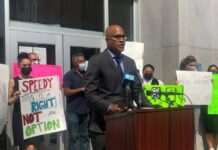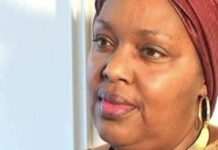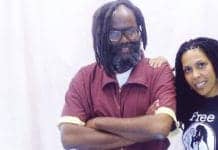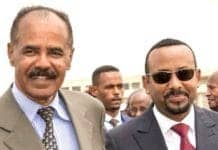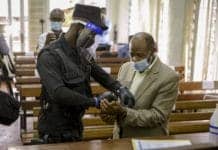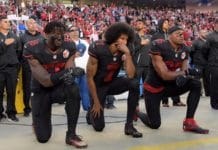by Ann Garrison
Syria has long dominated international headlines while the big powers discuss the possibility of dividing it into smaller, more homogeneous states along ethnic or religious lines. The Democratic Republic of Congo is rarely if ever at the top of the Western headlines, but heads of state and so-called experts have long made similar proposals to carve out new, smaller, more homogeneous nations in Congo’s resource-rich eastern provinces. I spoke with Congolese scholar and activist Boniface Musavuli about the plans.

Ann Garrison: Boniface, can you summarize the history of proposals to divide up the eastern provinces of the Democratic Republic of the Congo?
Boniface Musavuli: Attempts to break up the Congo began as soon as the country became independent in 1960. First there was the Katangese secession, from 1960 to 1963, led by Moïse Tshombe with the support of Belgium, the colonial power that Congo had just freed itself from, in name at least.
Katanga is Congo’s most southeastern province, bordering Angola, Zambia and Tanzania, which makes it easier to slice off, like the rest of the resource-rich eastern border provinces. Katanga is also Congo’s most mineral-rich province, and the Belgians had made it clear, before independence, that they did not intend to cede control of its wealth to the Congolese.
Another secession began in the southern part of Kasai Province, which borders Katanga. These secessions were defeated by U.N. forces and the Congolese army led by Lt.-Gen. Joseph-Désiré Mobutu, who was then chief of staff of the armed forces.
In October 1996, Rwandan President Pasteur Bizimungu called for the organization of a new Berlin Conference to allow Rwanda to take possession of part of eastern Congo. Bizimungu was a Hutu figurehead concealing the minority Tutsi rule that Gen. Paul Kagame had reestablished at the end of the 1990-1994 invasion, war and genocide in Rwanda.
At the same time, U.S. official and corporatist Walter Kansteiner began advocating ethnic Balkanization, including the creation of a homogeneous Tutsi state in eastern Congo.
AG: I’ve read about Kansteiner. He was Bill Clinton’s national security council advisor for African affairs, then he became deputy spokesman for Clinton’s National Security Council and, in 2002, he became George W. Bush’s assistant secretary of state for African affairs.
He’s been involved in mergers, acquisitions and privatizations all over Africa, and he owns a commodity trading firm in Chicago that specializes in tropical products. He’s a member of the Corporate Council on Africa, the Council on Foreign Relations and the African Development Foundation.
BM: Yes, that’s him. And he began advocating for the Balkanization of Congo along ethnic lines in October 1996.
AG: October 1996 was also the month when Uganda and Rwanda invaded the Congo, formed a coalition army with Laurent Désiré Kabila, and drove Congolese President Mobutu Sese Seko into exile seven months later.
BM: Yes, and then in 1998, during the Second Congo War, the DRC and its vast resources were divided into three main parts, even though there was no formal secession. One part was controlled by Congolese President Laurent-Désiré Kabila and his allies, another by Rwandan President Paul Kagame and his allies, and the third by Ugandan President Yoweri Museveni and his allies. This de facto partition of the country ended in 2003 when the Sun City peace agreement was signed in South Africa.
AG: I read some of the press about the Sun City Agreement at the time. It was reported that Uganda had agreed to give the Congolese finance portfolio to Congo in exchange for the power to choose the president of Congo’s 500-member national assembly, and Rwanda got to choose the head of Congo’s 120-member Senate, but that these bargains were not spelled out in the agreement.
BM: Yes, but it’s important to note that Congolese President Laurent Kabila had been assassinated in 2001, and succeeded by Joseph Kabila, his adopted son, who became a partner in U.S. and Rwandan Tutsi interests in Congo.
AG: WorldBiography.com reports that “Only a week after he [Kabila] was sworn in as president, George Bush invited Kabila to visit Washington. Kabila accepted the invitation and went there to meet with Colin Powell and Paul Kagame, the president of Rwanda.”
BM: Yes. So the 2003 Sun City Agreement was really an agreement between the Rwandan government in Kigali, the Ugandan government in Kampala, and the Rwandan government in Kinshasa, which was pretending to be Congolese. The agreement marked the next stage in a long period of veiled occupation that continues in Congo today.
By January 2009, French President Nicolas Sarkozy declared publicly that Congo must share its space and wealth with Rwanda.
AG: What proposals are currently on the table, and who is proposing them?
BM: There are now several initiatives aimed at Balkanizing Congo, but the Congolese have always opposed them. That explains, for example, the defeat of M23, an armed Tutsi militia, in November 2013.
A petition was recently launched by individuals who claimed to be from the Hutu community in Congo, calling for the partition of North Kivu, one of Congo’s most resource-rich and population-dense provinces. North Kivu borders Rwanda, and Rwandan forces have never left the province despite the 2003 agreement that formally ended the Second Congo War.
Instead they pretended to be Congolese and renamed themselves the National Congress for the Defense of the People (CNDP) and then the March 23 Movement (M23). North Kivu continued to be ravaged by their violence and looting of Congolese resources, including coltan, gold, diamonds and timber.
This partition of North Kivu would weaken the inter-ethnic cohesion of the province, weaken its different territories and cause massive population displacements. There are already more than 1.1 million internally displaced persons (IDPs) in North Kivu Province, nearly a quarter of the 4.5 million IDPs in the country.
Partitioning the territories of North Kivu would facilitate their annexation to Rwanda, as envisioned by the Balkanizers back in 1996. The people behind this petition are in fact linked to Kagame and Kabila’s Tutsi expansionist regimes, which have always worked together to Balkanize eastern Congo. This explains the massive presence of Rwandan Tutsi officers in the ranks of the Congolese army.
However, the Rwandan military presence is not sufficient to achieve Balkanization. This also requires huge Rwandan populations on Congolese soil. Hence their massive arrival, particularly in North Kivu Province’s Beni Territory and Ituri Province. Some of these Rwandans commit massacres against the indigenous populations, which explains the hostility of the Congolese to their arrival.

AG: Is the plan to populate the territories that Rwanda would like to annex with Rwandans and then hold a referendum on whether the territories want to be part of Rwanda or Congo?
BM: Yes. Rwanda’s strategy has always been to use populations of Rwandan origin, or of Rwandan ancestry. By sending Rwandan populations to Congo and massacring native Congolese, Rwanda is trying to create a Rwandan majority in several provinces or territories of Congo.
If they become a majority, these populations will be able to demand a referendum of self-determination and obtain the autonomy of the territories under their control. Then, after autonomy, these territories could be annexed to Rwanda.
However, it should be noted that a large part of the populations of Rwandan origin or ancestry, now established in Congo for several generations, oppose the Balkanization. These populations now consider themselves Congolese and refuse to collaborate in the Kagame regime’s expansionist ambitions. This is one of the main reasons why the Balkanization project is floundering.
AG: And are the Balkanizers, both here and there, trying to Balkanize North Kivu, Ituri and maybe more of Congo’s resource-rich east along ethnic lines? The U.S. has pursued a policy of ethnic and/or religious division since the breakup of Yugoslavia, then Iraq, South Sudan and now Syria.
BM: Yes, and Walter Kansteiner spoke about the creation of an ethnically homogeneous Tutsi state in eastern Congo. It’s a terrifying idea because Tutsi do not even represent 5 percent of the total population of Kivu and are not a majority in any Congolese territory.
The only way for them to have a homogeneous state is to slaughter 95 percent of the local population or drive them off their land. That explains in part the death of six million Congolese and the continuation of the massacres in eastern Congo.
But despite these unending massacres and millions of deaths, the Tutsi still remain a minority throughout the eastern Congo. They cannot create a homogeneous state in eastern Congo, but perhaps they can create a totalitarian state like Rwanda’s, where a tiny, super-militarized Tutsi minority reigns supreme over the country and crushes the majority Hutu population.
AG: In her new book, “In Praise of Blood: Crimes of the Rwandan Patriotic Front,” Judi Rever writes:
“The market analyst predicted a complete geostrategic restructuring in central Africa, with Rwandan Tutsis, an ethnic group that had faced existential threats for decades, now steering affairs. ‘You’ll see a de facto “Greater Tutsi Land” there. What you’ve got is a situation where Rwanda and Uganda are clearly now the dominant military powers in the region. They will do pretty much what they want.”
Do you agree that that’s what’s happened?
BM: Yes, absolutely. The Hima powers of Uganda and Tutsi of Rwanda are the dominant military force in the region. Although they are a minority in number, they control virtually all military decisions in the DRC and, of course, in Uganda and Rwanda. They operate within the framework of the American strategy of entrusting the “real power” to the minority communities even if they enslave the majority.
AG: Isn’t Ugandan President Yoweri Museveni a Tutsi, like Rwandan President Paul Kagame, though this is rarely discussed?
BM: Museveni was born in 1944. His parents were nomads from the Western Uganda Bahima subgroup of the Banyankole people, closely related to the Tutsis of Rwanda and Burundi.
AG: And was this elite minority ruling class selected and empowered by the U.S. and its Western allies?
BM: Yes indeed. That is why elites in the Western countries remain silent about the terrible crimes that Kagame and Museveni have committed in the African Great Lakes region for more than 20 years. More than 6 million Congolese people have died by their crimes, but not a single Ugandan or Rwandan leader faces prosecution anywhere in the world.
AG: Pundits and policymakers here in the U.S. argue that Congo is a “weak state,” so they need to break it up into smaller, stronger states. The 1961 assassination of Patrice Lumumba, the first democratically elected, post-independence prime minister, by U.S. and Belgian operatives has precluded the possibility of Congo becoming a strong state for nearly 60 years.
BM: Congo is not a weak state, but a state where the occupying authorities intentionally weakened the state. Since Joseph Kabila came to power in 2001, every solution proposed – such as building a road, fighting corruption or eliminating an armed group – has been sabotaged, so the problems only worsen.
Why? Because the current authorities controlling the DRC, including President Kabila, have all come from Rwanda and Uganda, behind the armed movement that has been constantly renamed, from AFDL to RCD, CNDP, then M23. These authorities are on a mission to keep the Congolese state permanently weak, so that Kagame, their boss, can pursue his expansionist agenda in Congo.
When Congolese get rid of Kagame’s henchman Joseph Kabila, they will work to rebuild their country with a strong state. As it is now, 85 percent of Congolese mineral resources are looted by members of the regime and their foreign allies. If the Congolese reclaim their own resources, Congo can rapidly become a strong and wealthy state with a high standard of living.
AG: Who opposes the division of the Democratic Republic of Congo?
BM: The Congolese as a whole are strongly opposed to the Balkanization of their country. Congo is a multiethnic nation, but there is not a single Congolese community that supports Balkanization along ethnic lines.
Boniface Musavuli is a Congolese author and political exile living in France. He is the author of the book “Les Massacres de Beni: Kabila, le Rwanda et les Faux Islamistes “ (“The Massacres of Beni: Kabila, Rwanda, and the Faux Islamists”). This book will soon be published in English. He is also the author of “Les Genocides des Congolais – De Leopold II à Paul Kagame“ (“The Genocides of the Congolese – from Leopold II to Paul Kagame”).
Ann Garrison is an independent journalist living in the San Francisco Bay Area. In 2014, she received the Victoire Ingabire Umuhoza Democracy and Peace Prize for her reporting on conflict in the African Great Lakes Region. She can be reached at @AnnGarrison or ann@kpfa.org.

 Store
Store



